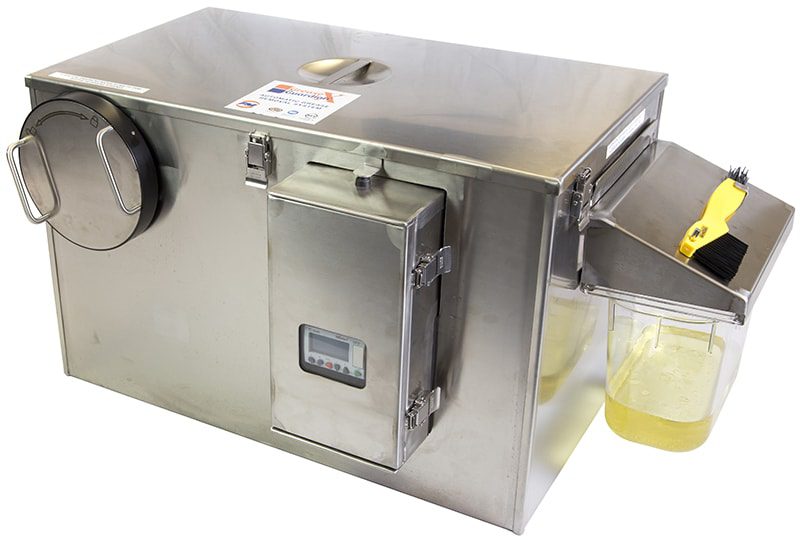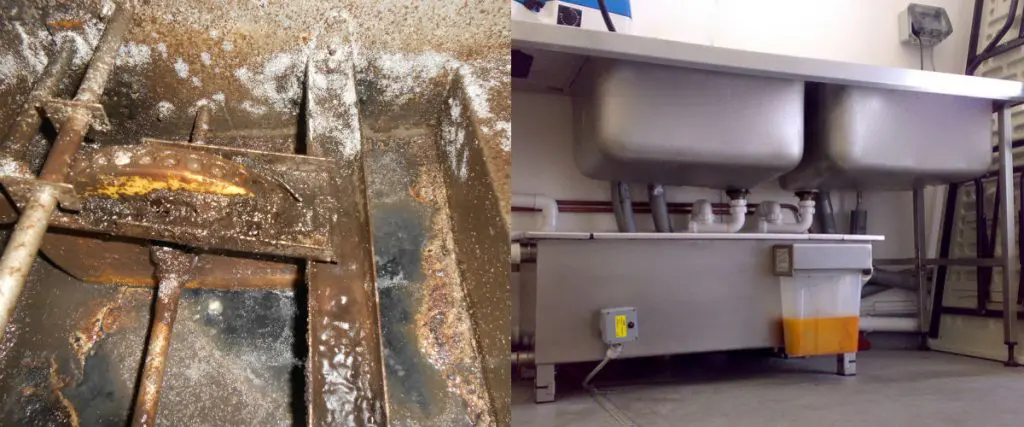How Does a Restaurant Grease Trap Work? Experts Explain Fast
Grease traps are essential for any restaurant to prevent fats, oils, and grease (FOG) from clogging the plumbing and causing costly repairs.
Proper maintenance is key to keeping your kitchen running smoothly and meeting local regulations.
In this guide, we’ll dive into how grease traps work, why they’re so important, and how to maintain them effectively.
How does a restaurant grease trap work?
A restaurant grease trap captures grease and food solids before they enter the plumbing system. It works by slowing down wastewater, allowing the grease to float while solids settle at the bottom.
Key Takeaways
- Grease traps prevent grease, fats, and oils from entering the plumbing system, avoiding clogs and blockages.
- They work by allowing grease to float to the top of the water while wastewater flows beneath.
- Regular grease trap cleaning and maintenance are crucial for efficient grease trap performance.
What is a Grease Trap and Why Is It Important?

A grease trap, also known as a grease interceptor, is a plumbing device installed in kitchens, especially in restaurants, to prevent grease, fats, and oils from flowing into the wastewater system.
These substances can cause serious blockages in the pipes and lead to the creation of fatbergs, which are large masses of congealed grease and waste that clog sewer systems.
Without a grease trap, grease would travel down the drain, causing costly repairs and potential environmental issues.
How Does a Grease Trap Work?
The process of how a grease trap works is relatively simple but highly effective. Here’s a breakdown of the key steps in the process:
1. Water Enters the Grease Trap
When wastewater from the kitchen flows into the grease trap, it carries food waste, grease, oils, and other substances.
This water enters the first compartment of the grease trap, which is designed to hold the wastewater temporarily.
2. Separation of Grease and Water
As the water sits in the trap, the heavier solids, such as food particles, settle at the bottom of the trap.
Grease, being less dense than water, rises to the top, where it forms a layer of floating grease and oil.
The wastewater, which is now free from the majority of grease, flows beneath this greasy layer and continues to the plumbing system for disposal.
3. Wastewater Discharges
Once the water has been filtered through the grease trap, it exits the system through an outlet pipe and flows into the main wastewater system.
The grease and solid waste remain trapped in the grease trap, preventing them from entering the sewage system.
Types of Grease Traps

There are two main types of grease traps that restaurants commonly use: passive and mechanical.
Each type works in slightly different ways but serves the same purpose: to trap grease before it can reach the plumbing system.
1. Passive Grease Traps
Passive grease traps are the most common type and are typically installed under sinks or in kitchen floors.
These traps rely on gravity to separate grease from water. The grease rises to the top, while the wastewater moves to the bottom and exits the trap.
Advantages: They are simple to install and don’t require external power sources.
Disadvantages: They need to be regularly cleaned and may not be large enough to handle the volume of grease in a busy commercial kitchen.
2. Mechanical Grease Traps
Mechanical grease traps use pumps, motors, or other mechanisms to assist in separating grease from water.
These traps are often larger and more efficient than passive systems, making them ideal for high-volume kitchens.
Advantages: More efficient at handling large amounts of grease and require less frequent cleaning.
Disadvantages: They are more expensive to install and maintain due to the mechanical components.
The Importance of Regular Maintenance
Grease traps need regular maintenance to function properly.
If they are not cleaned and maintained, the grease can build up and clog the system, reducing its efficiency and potentially causing plumbing issues. Here’s what regular maintenance entails:
1. Cleaning the Grease Trap
To keep the grease trap working effectively, it should be cleaned regularly, usually every 1-3 months depending on the volume of grease produced by the restaurant.
The cleaning process involves removing the grease, solid waste, and water from the trap and disposing of it properly.
How to Clean: Start by draining the grease trap, removing any solid waste, and scraping out the grease layer.
Use a degreaser to clean the inside of the trap, and make sure the inlet and outlet pipes are free from blockages.
2. Inspecting for Damage
During the cleaning process, it’s essential to inspect the grease trap for any signs of damage or wear.
Check for leaks, cracks, or any parts that may need to be replaced, such as gaskets or filters.
Regular inspection ensures that the trap continues to function properly and prevents costly repairs down the line.
3. Monitoring Grease Accumulation
Keep track of how quickly the grease trap fills up with grease and solids.
If the trap is filling up more quickly than usual, it may indicate that your system is not working as efficiently as it should.
In such cases, it’s advisable to consult a professional to assess the system’s performance.
Signs Your Grease Trap Needs Maintenance

It’s essential to know the signs that your grease trap may need attention. If you notice any of the following, it could be an indication that your grease trap is clogged or needs maintenance:
Slow Draining: If the water in the sink is draining slower than usual, it could be a sign that the grease trap is clogged and needs cleaning.
Foul Odours: A smelly or unpleasant odour coming from the kitchen drains or the grease trap area is another common sign that the trap is full and requires cleaning.
Backed-up Water: If water starts to back up in the sink or dishwasher, it may indicate that the grease trap is unable to separate the grease properly, causing a blockage in the plumbing system.
How to Prevent Overloading Your Grease Trap
Preventing grease overload is key to maintaining a functional grease trap. Here are some tips to avoid overloading your grease trap:
Install a Grease Interceptor: A larger grease interceptor can help catch more grease before it enters the grease trap, reducing the need for frequent cleaning.
Use Grease Strainers: Installing grease strainers in sinks and dishwashers can help reduce the amount of grease and food particles that make it to the trap.
Train Staff: Educate kitchen staff on proper grease disposal and how to prevent excess grease from entering the trap.
Frequently Asked Questions
1. How often should I clean my grease trap?
Most commercial kitchens should clean their grease trap every 1-3 months, depending on the volume of grease generated. High-volume kitchens may require more frequent cleaning.
2. Can I install a grease trap myself?
While installing a grease trap is possible for those with plumbing knowledge, it’s often best to have a professional install the system to ensure it’s done correctly and in compliance with local regulations.
3. What happens if I don’t clean my grease trap?
If you neglect to clean your grease trap, it can lead to blockages, foul odours, plumbing issues, and even health code violations. Regular cleaning is necessary to keep the system working efficiently.
Conclusion
A grease trap is an essential part of any restaurant’s waste management system.
It plays a vital role in keeping the plumbing system free from blockages and ensuring that grease does not pollute the local water supply.
Regular maintenance and cleaning are key to ensuring that your grease trap functions properly and lasts for years to come.
By understanding how grease traps work and keeping up with proper care, you can prevent costly repairs and ensure that your kitchen runs smoothly.
